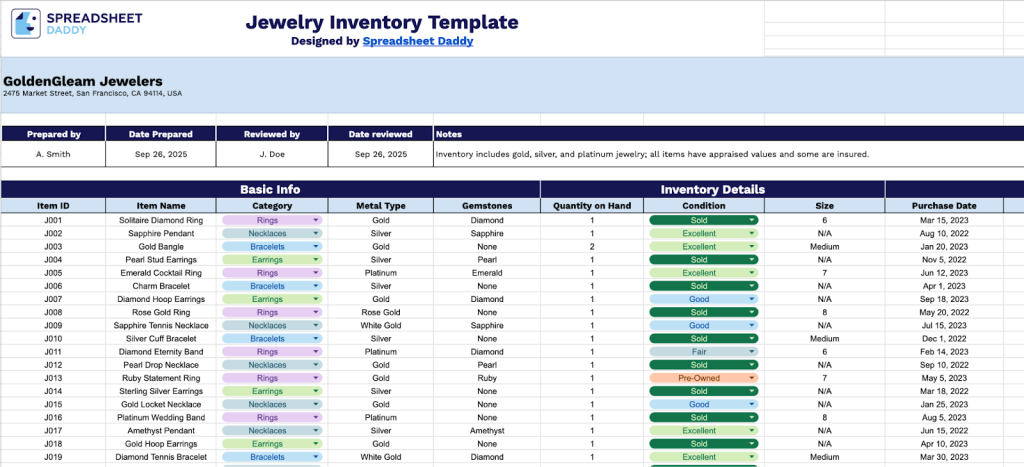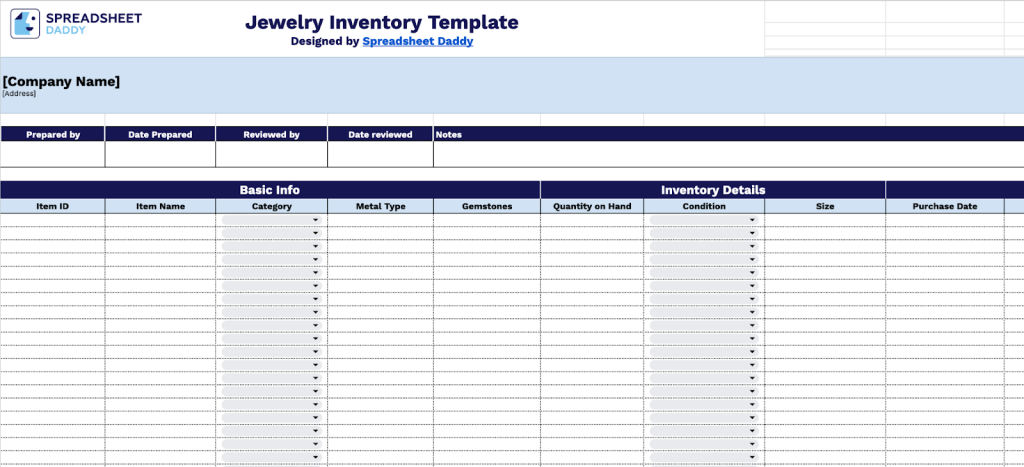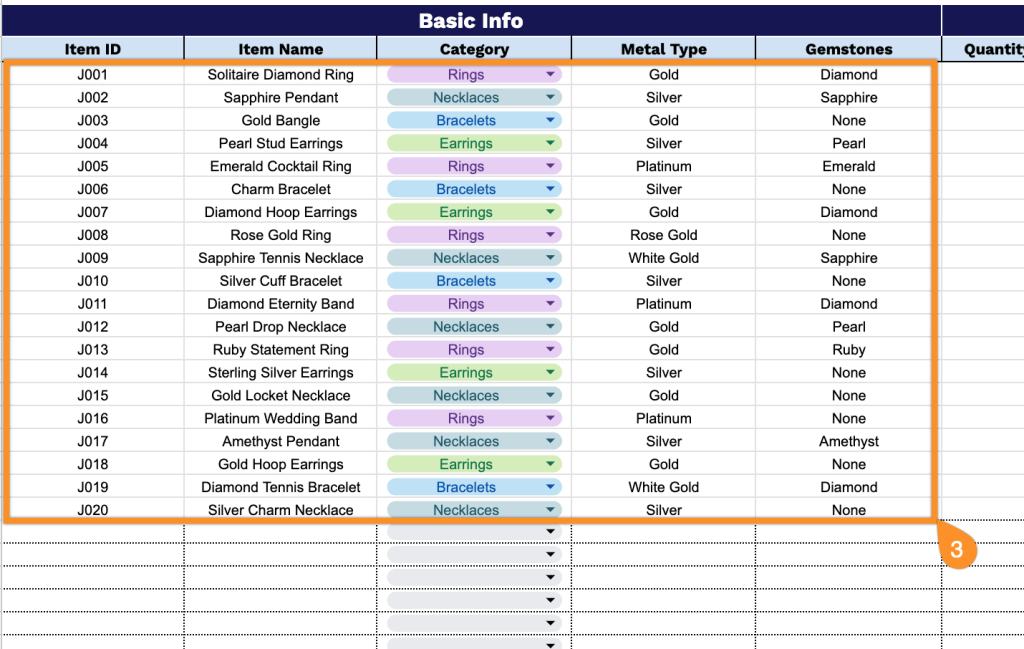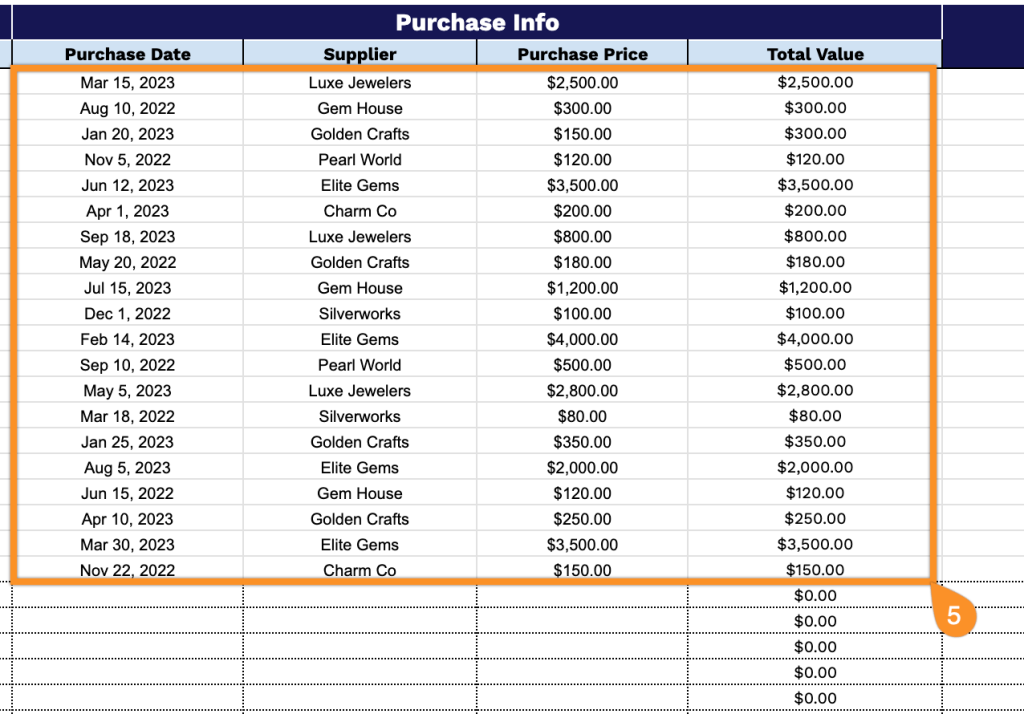Lost track of that sapphire pendant? Can’t remember which supplier sent the last batch of sterling silver chains? Jewelry inventory has a way of spiraling into chaos faster than you can say “misplaced earring.”
The problem isn’t just about knowing what you have; it’s also about understanding what you have. It’s about accessing critical information the moment you need it: carat weights, purchase dates, cost breakdowns, and current location.
A dedicated inventory spreadsheet transforms that jumble of information into a searchable, sortable system that actually works for your operations. This free template adapts to your workflow, whether you’re working in Google Sheets, Excel, or printing it out the old-fashioned way.
No learning curve, no subscription fees, just a straightforward organization that keeps your jewelry business or collection running smoothly.
Quick Jump
ToggleWhat Is a Jewelry Inventory Spreadsheet?

A jewelry inventory spreadsheet is a digital document used to organize and track detailed information about a jewelry collection, whether for personal, retail, or insurance purposes.
This tool helps owners maintain accurate records for insurance claims, estate planning, tracking resale value, or simply managing a growing collection efficiently.
Download Spreadsheet Daddy’s Free Jewelry Inventory Management Spreadsheet

Our comprehensive jewelry inventory template helps you track and manage your jewelry collection with detailed organization.
Perfect for jewelry retailers, collectors, or insurance documentation, this template automatically calculates total values and provides a professional format for inventory management. You can easily customize it by adding or removing columns to fit your specific needs.
What’s included
- Comprehensive item identification system: Track each piece with a unique Item ID, Item Name, Category, Metal Type, and Gemstones fields to create a complete catalog of your jewelry inventory with precise product specifications.
- Detailed inventory management fields: Monitor stock levels with Quantity on Hand tracking, Condition status, and Size specifications to maintain accurate records of available merchandise and product quality.
- Complete purchase history documentation: Record Purchase Date, Supplier information, and Purchase Price for each item to maintain vendor relationships and track acquisition costs across your jewelry collection.
- Automated financial calculations: Built-in Total Value column with currency formatting provides instant visibility into individual item values and overall inventory worth for financial reporting and insurance purposes.
- Organized documentation structure: Professional header section includes fields for company name, address, preparer and reviewer information with dates, plus a dedicated Notes column for recording special characteristics, provenance, or storage details.
How to Use Our Jewelry Inventory Spreadsheet Template
1. Begin organizing your jewelry collection by copying this template to Google Sheets or downloading it as Excel/PDF.
2. Register your business title, physical address, stock coordinator details, and finalization date. Specify the management representative’s name with the assessment date. Employ the Notes field to record supplementary data.

3. Complete the Item Details section by entering all essential jewelry information:
- Item ID: Enter the unique identifier or SKU assigned to each jewelry piece for inventory tracking.
- Item Name: Specify the complete product name and style description of the jewelry item.
- Category: Select the appropriate jewelry classification (Rings, Necklaces, Bracelets, Earrings, etc.).
- Metal Type: Document the precious metal composition (gold, silver, platinum, etc.) and purity level.
- Gemstones: Record all gemstones featured in the piece, including type, carat weight, and quality grades.

4. Track inventory status and physical characteristics in the Inventory Details section:
- Quantity on Hand: Document the current number of pieces available for immediate sale.
- Condition: Specify the item’s state (Excellent, Good, Fair, Pre-Owned, etc.).
- Size: Record sizing information such as ring size, chain length, or bracelet dimensions.

5. Document acquisition details in the Purchase Info section for valuation and tracking:
- Purchase Date: Enter the date when the jewelry item was acquired or received into inventory.
- Supplier: Record the name of the vendor, wholesaler, or estate from which the piece was purchased.
- Purchase Price: Document the wholesale cost paid to acquire the individual piece of jewelry.
- Total Value: The template automatically calculates the complete investment, including purchase price and any additional acquisition costs.

6. Include any extra or specific information about each piece in the Notes section.
